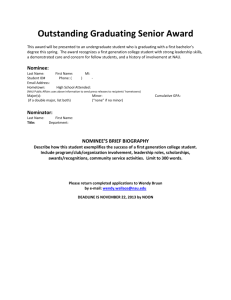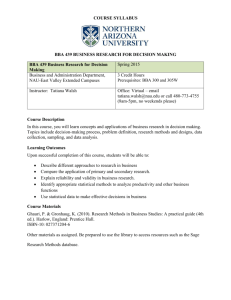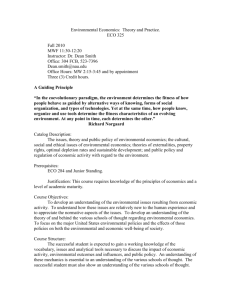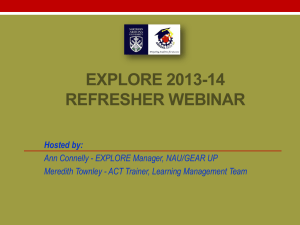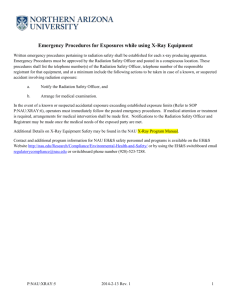ART 258 - nau.edu - Northern Arizona University
advertisement
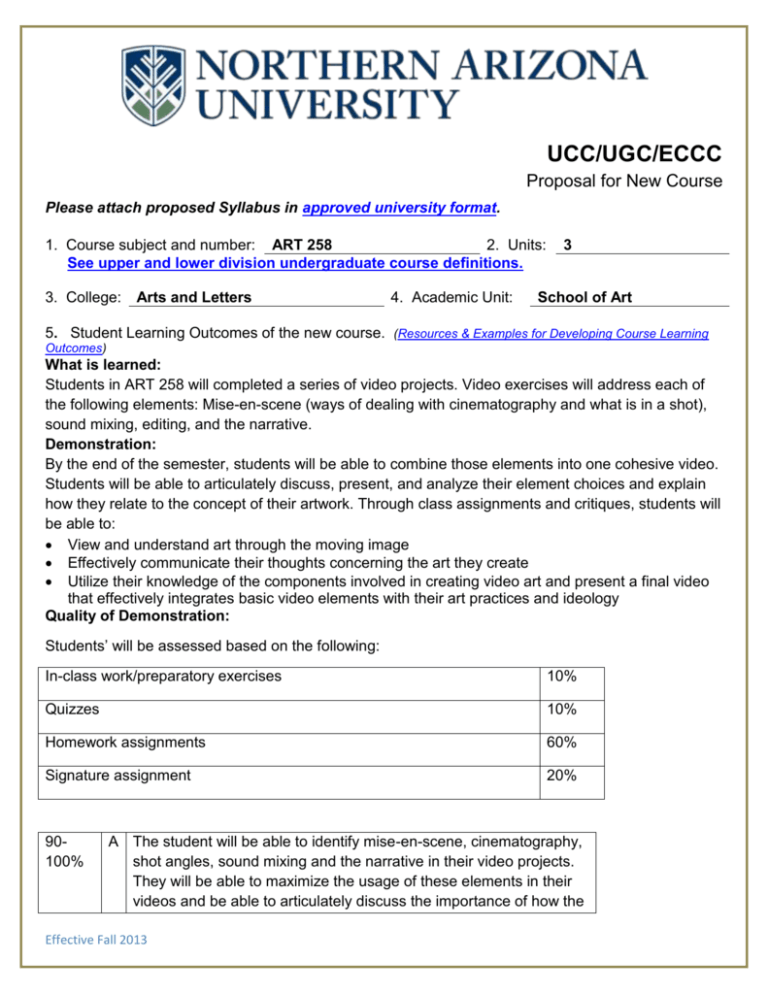
UCC/UGC/ECCC Proposal for New Course Please attach proposed Syllabus in approved university format. 1. Course subject and number: ART 258 2. Units: See upper and lower division undergraduate course definitions. 3. College: Arts and Letters 4. Academic Unit: 3 School of Art 5. Student Learning Outcomes of the new course. (Resources & Examples for Developing Course Learning Outcomes) What is learned: Students in ART 258 will completed a series of video projects. Video exercises will address each of the following elements: Mise-en-scene (ways of dealing with cinematography and what is in a shot), sound mixing, editing, and the narrative. Demonstration: By the end of the semester, students will be able to combine those elements into one cohesive video. Students will be able to articulately discuss, present, and analyze their element choices and explain how they relate to the concept of their artwork. Through class assignments and critiques, students will be able to: View and understand art through the moving image Effectively communicate their thoughts concerning the art they create Utilize their knowledge of the components involved in creating video art and present a final video that effectively integrates basic video elements with their art practices and ideology Quality of Demonstration: Students’ will be assessed based on the following: In-class work/preparatory exercises 10% Quizzes 10% Homework assignments 60% Signature assignment 20% 90100% A The student will be able to identify mise-en-scene, cinematography, shot angles, sound mixing and the narrative in their video projects. They will be able to maximize the usage of these elements in their videos and be able to articulately discuss the importance of how the Effective Fall 2013 elements affect their concept. 8089% B Students demonstrate an understanding of mise-en-scene, cinematography, shot angles, sound mixing and the narrative in their video projects. They can use all the elements and can link three or more elements to their video work. Work is completed and turned in on time. 7079% C Students demonstrate basic understanding and competency of mise-en-scene, cinematography, shot angles, sound mixing, and the narrative in their video projects. They can use the elements and link at least two elements with the concept of their work. They meet all knowledge, skills, and dispositions in an average manner. Work is completed and turned in on time. 6069% D Students inadequately connect the topics learned in class with the video work they produce. Work is completed in a below-average manner or is late, incomplete, or unprofessionally presented; student demonstrates nominal understanding and competency; demonstrates limited knowledge, skills, and dispositions. Below 60% F Students cannot identify or discuss the various elements involved in the construction of a video art piece. The students’ work does not meet the minimum requirements per assignment, it is incomplete, or is not turned in at all. Unacceptable work does not demonstrate acceptable knowledge, skills, and dispositions. 6. Justification for new course, including how the course contributes to degree program outcomes, or other university requirements / student learning outcomes. (Resources, Examples & Tools for Developing Effective Program Student Learning Outcomes). Based on prior success of the class tested under Special Topics in Art and the assessment of students’ needs, ART 258 offers a contemporary studio course for students in the School of Art and university wide. ART 258 gives students the opportunity to integrate art creation and thought process with technology in the classroom. The School of Art is integrating traditional art practices with contemporary art focuses. This is one of the classes that will deal with expanding art practices. No other course of this kind is currently being offered in the School of Art. 7. Effective BEGINNING of what term and year? See effective dates calendar. Fall 2014 8. Long course title: INTRODUCTION TO VIDEO ART (max 100 characters including spaces) 9. Short course title: Effective Fall 2013 INTRODUCTION TO VIDEO ART (max. 30 characters including spaces) 10. Catalog course description (max. 60 words, excluding requisites): This is a studio art course that will introduce students to basic elements involved in creating video art. Discussions will center on the components that go into putting together and evaluating video art, including mise-en scene, cinematography, editing, sound mixing and the narrative. 11. Will this course be part of any plan (major, minor or certificate) or sub plan (emphasis)? Yes No If yes, include the appropriate plan proposal. The School of Art is working toward developing an area called Expanding Practices, but this emphasis in the BFA degree is not yet being proposed. This will integrate contemporary art disciplines and digital practices into the traditional studio courses. At this time, this class is an elective; however, in the future we will seek to incorporate this course into the Expanding Practices emphasis. 12. Does this course duplicate content of existing courses? Yes No If yes, list the courses with duplicate material. If the duplication is greater than 20%, explain why NAU should establish this course. 13. Will this course impact any other academic unit’s enrollment or plan(s)? Yes No If yes, describe the impact. If applicable, include evidence of notification to and/or response from each impacted academic unit 14. Grading option: Letter grade Pass/Fail Both 15. Co-convened with: 14a. UGC approval date*: (For example: ESE 450 and ESE 550) See co-convening policy. *Must be approved by UGC before UCC submission, and both course syllabi must be presented. 16. Cross-listed with: (For example: ES 450 and DIS 450) See cross listing policy. Please submit a single cross-listed syllabus that will be used for all cross-listed courses. 17. May course be repeated for additional units? 16a. If yes, maximum units allowed? 16b. If yes, may course be repeated for additional units in the same term? Yes No Yes No 18. Prerequisites: ART 136 If prerequisites, include the rationale for the prerequisites. ART 136 is our second level drawing course. In it, we introduce students to the basic compositional principles. Students should know how to compose an image and utilize Effective Fall 2013 compositions in order to know what can work within the camera lens. ART 136 will support students’ ability to plan video art production through the production of thumbnail sketching, space planning, and shot composition, etc. 19. Co requisites: If co requisites, include the rationale for the co requisites. 20. Does this course include combined lecture and lab components? Yes If yes, include the units specific to each component in the course description above. 21. Names of the current faculty qualified to teach this course: No Debra Edgerton/David VanNess 22. Classes scheduled before the regular term begins and/or after the regular term ends may require additional action. Review “see description” and “see impacts” for “Classes Starting/Ending Outside Regular Term” under the heading “Forms” http://nau.edu/Registrar/Faculty-Resources/Schedule-of-Classes-Maintenance/. Do you anticipate this course will be scheduled outside the regular term? Yes No 23. Is this course being proposed for Liberal Studies designation? If yes, include a Liberal Studies proposal and syllabus with this proposal. Yes No 24. Is this course being proposed for Diversity designation? If yes, include a Diversity proposal and syllabus with this proposal. Yes No Answer 22-23 for UCC/ECCC only: FLAGSTAFF MOUNTAIN CAMPUS Scott Galland Reviewed by Curriculum Process Associate 11/18/2013 Date Approvals: Department Chair/Unit Head (if appropriate) Date Chair of college curriculum committee Date Dean of college Date For Committee use only: Effective Fall 2013 UCC/UGC Approval Date Approved as submitted: Yes No Approved as modified: Yes No EXTENDED CAMPUSES Reviewed by Curriculum Process Associate Date Approvals: Academic Unit Head Date Division Curriculum Committee (Yuma, Yavapai, or Personalized Learning) Date Division Administrator in Extended Campuses (Yuma, Yavapai, or Personalized Learning) Date Faculty Chair of Extended Campuses Curriculum Committee (Yuma, Yavapai, or Personalized Learning) Date Chief Academic Officer; Extended Campuses (or Designee) Date Approved as submitted: Yes No Approved as modified: Yes No Effective Fall 2013 College of Arts and Letter School of Art ART 258: Introduction to Video Art Liberal Studies Class Fall 2014 T/R 2:20 to 4:25pm Credits Hours: 3 (Studio Art classes require 4 hours 10 min. of contact and at least 4-6 hours of independent work each week.) Instructor: Debra Edgerton School of Art, Box 6020 Northern Arizona University, Flagstaff AZ. 86011 Office: Bldg. 37, rm. 325 Phone: 523-8781 Office Hours: 4:30 to 5:30pm T/R E-mail: Debra.Edgerton@nau.edu COURSE PRE-REQUISITES: ART 136 COURSE DESCRIPTION: This is a studio art course that will introduce students to basic elements involved in creating video art. Discussions and projects will center on topical components that go into putting together and evaluating a film including: mise-en scene, cinematography, editing, sound mixing and the narrative. This course will enhance students’ ability to contextualize their artwork and help them determine their creative voice within the framework of their environment and the moving images. Mission of Liberal Studies: The mission of the Liberal Studies Program at Northern Arizona University is to prepare students to live responsible, productive, and creative lives as citizens of a dramatically changing world. To accomplish the mission of Liberal Studies, Northern Arizona University provides a program that challenges students to gain a deeper understanding of the natural environment and the world’s peoples, to explore the traditions and legacies that have created the dynamics and tensions that shape the world, to examine their potential contributions to society, and thus to better determine their own places in that world. Through the program students acquire a broad range of knowledge and develop essential skills for professional success and life beyond graduation. DISTRIBUTION BLOCK: This is a liberal studies course in the Aesthetic and Humanistic Inquiry distribution block. ESSENTIAL SKILLS Through observation-based assignments, students will: Learn how to work with editing software Become familiar with small hand-held digital video cameras Understand basics elements involved in putting together a video Explore different ways to approach movie making Effective Fall 2013 Because this is a hands-on course, students are required to attend class to work on their projects and to participate in discussions of film elements and how they apply to the work they will be producing. LEARNING OUTCOMES: Students in Introduction to Video Art will complete a series of video projects. Video exercises will address each of the following elements: Mise-en-scene (ways of dealing with cinematography and what is in a shot), sound mixing, editing, and the narrative. By the end of the semester, students will be able to combine those elements into one cohesive video. Students will be able to articulately discuss, present, and analyze their element choices and explain how they relate to the concept of their artwork. Through class assignments and critiques, students will be able to: View and understand art through the moving image Effectively communicate their thoughts concerning the art they create. Utilize their knowledge of the components involved in creating video art and present a final video that effectively integrates basic video elements with their art practice and ideology. This course will enhance student’s ability to contextualize their artwork with various forms of visual, written, and verbal expression and to bring their own personal thought process into the work they create. COURSE STRUCTURE/COURSE OBJECTIVES This course is designed primarily as a studio course with brief lectures, hands on instruction, video viewing, and work with digital cameras and laptop computer editing. The objective of this course is to understand the basics of filmmaking and apply this knowledge to the making of short video pieces. Each video will be based on the topics covered in class. Students will continue to develop critical thinking skills. Students will utilize skills in analyzing film clips and apply that knowledge to the development of short video art pieces. Students will also continue to work on communication skills to discuss the effectiveness of the works being created and presented in class. TEXTBOOK AND REQUIRED MATERIALS: Excerpts from Introduction to Film Art and additional handouts COURSE OUTLINE Week 1 (Aug. 31st –Sept 2nd): Introduction to the class. This will include an overview of the syllabus and a discussion on what video can mean as art. Students will bring in a clip that expresses what they consider a noteworthy moving image from their perspective. They must explain why their chosen clip affects how they view the moving image. Week 2 (Sept. 7th- 9th): Students create example clips without instruction. This assignment is to assess how students construct and see the moving images. Week 3 (Sept. 14th-16th): Topic: Intro to “the Shot” Part one Mise-en-Scene. Discuss the meaning and see clips. (Examples of Chiaroscuro clip from “El Sur” by Victor Eric; Example of color: clip from Tampopo) Part two: Cinematography, discussion and clips Clips from Days of Heaven (Locust scene) and City of God (Intro) to show High and Low angle shots. Effective Fall 2013 Week 4 (Sept 21st- 23rd): Assignment one: Cinematography. Students will create a short video, taking into consideration what is in the shot and what vantage point will work best with the subject matter. Week 5 (Sept 28th -30th): Demonstration on how to work with iMovie and Live Moviemaker Week 6 (Oct. 5th – 7th): Time for editing Project one Week 7 (Oct. 12th – 14th): Project one due Week 8 (Oct. 19th – 21st): Topic: Sound Discussion Compare and contrast sound mixing with clips from Seven Samurai and The Last of the Mohicans Sound Effects vs. Narrative with clips from A Man Escaped and La Jetee Diegetic vs. Nondiegetics sound (clip from Little Shop of Horrors) Week 9 ((Oct. 26th – 28th): working on Project two Week 10 ((Nov. 2nd – 4th): Project two due Week 11 (Nov. 9th – 11th) Project 3 Week 12 (Nov. 16th -18th): One-on-one help connecting part one and two Week 13 (Nov. 23rd): Project 3 and Thanksgiving Week 14 (Nov. 30th –Final project Week 15 (Dec. 7th -9th): Final project due Dec. 9th ASSESSMENT OF STUDENT LEARNING OUTCOMES Individual grades will be assessed through classroom discussions, critique participation, writing analysis, and production of class assignments. Late work will be automatically assessed a 10% grade reduction for each class day it is late. Grades will be based on the following: Evaluation/Assessment Final grades will be calculated according to the following chart: In-class work/preparatory exercises 10% Quizzes 10% Homework assignments 60% Signature assignment 20% Assignments 1. In Class/preparatory work (10% of grade) Readings will be assigned and students are expected to participate in the class discussions and writing assignments based on these readings. Students will be required to research and present example clips that relate to the topics being discussed and how they relate to their areas of interest. Students will self analyze their video work and develop their ability to communicate their ideas into a visual form. 2. Quizzes (10% of grade) Quizzes will be given based on the readings and the topics discussed in class. These quizzes are important to the understanding of the relationship between art and the moving image. Effective Fall 2013 3. Homework assignment (60% of grade) Three assignments/projects (they will be discussed in class) Assessment will be based on understanding of project elements, the students’ ability to integrate topic elements into personal artist vision, creativity, and conceptual relationship between the art, the idea, and the moving image. 4. Signature assignment (20% of grade) Students will combine their knowledge of the semester topics to create a final video. Students must demonstrate an understanding of how to integrate their own art practices into the format of the moving image through effective use of the video elements. Each assignment has its own objective stated when the assignment is given. Work will be accessed based on the expectations per assignment. (The instructor reserves the right to add or change the material presented in class) 90100% A The student will be able to identify mise-en-scene, cinematography, shot angles, sound mixing and the narrative in their video projects. They will be able to maximize the usage of these elements in their videos and be able to articulately discuss the importance of how the elements affect their concept. 8089% B Students demonstrate an understanding of mise-en-scene, cinematography, shot angles, sound mixing and the narrative in their video projects. They can use all the elements and can link three or more elements to their video work. Work is completed and turned in on time. 7079% C Students demonstrate basic understanding and competency of mise-en-scene, cinematography, shot angles, sound mixing, and the narrative in their video projects. They can use the elements and link at least two elements with the concept of their work. They meet all knowledge, skills, and dispositions in an average manner. Work is completed and turned in on time. 6069% D Students inadequately connect the topics learned in class with the video work they produce. Work is completed in a below-average manner or is late, incomplete, or unprofessionally presented; student demonstrates nominal understanding and competency; demonstrates limited knowledge, skills, and dispositions. Below 60% F Students cannot identify or discuss the various elements involved in the construction of a video art piece. The students’ work does not meet the minimum requirements per assignment, it is incomplete, or is not turned in at all. Unacceptable work does not demonstrate Effective Fall 2013 acceptable knowledge, skills, and dispositions. COURSE POLICY Attendance: The structure of the course requires consistent attendance. More than three (3) absences without an official health excuse (in writing) or an institutional excuse will result in the lowering of the final grade by one letter grade. Every absence after four will result in an additional letter grade drop until a failing grade in the course. Consistent tardiness will be reflected in the overall evaluation. Every three late classes will convert to one missed class. Statement on Plagiarism and Cheating: Plagiarism and cheating are subject to the Arizona Board of Regents' Code of Conduct and the procedures outlined in the NAU Student Handbook concerning the charges of these offenses. The university’s self-insurance plan does not provide for medical coverage to students if injured while participating in university related activities or academic programs. Students are strongly encouraged to obtain medical/health insurance prior to participation. This may be done either through your parents’ health-plan or by purchasing a health plan through Fronske Health Center. MATERIALS Laptop computer Flash/thumb drive 8G to 16G * (Additional supplies may be required depending on the projects and the student’s needs. Students will be expected to collect their own materials for their projects.) Students without laptop are required to use the facilities in the media studios at the Cline library. However, this means work must be brought it to be viewed at the beginning of each class. NORTHERN ARIZONA UNIVERSITY POLICY STATEMENTS SAFE ENVIRONMENT POLICY NAU’s Safe Working and Learning Environment Policy seeks to prohibit discrimination and promote the safety of all individuals within the university. The goal of this policy is to prevent the occurrence of discrimination on the basis of sex, race, color, age, national origin, religion, sexual orientation, disability, or veteran status and to prevent sexual harassment, sexual assault or retaliation by anyone at this university. You may obtain a copy of this policy from the college dean’s office or from the NAU’s Affirmative Action website http://www4.nau.edu/diversity/swale.htm. If you have concerns about this policy, it is important that you contact the departmental chair, dean’s office, the Office of Student Life (928-523-5181), or NAU’s Office of Affirmative Action (928-523-3312). STUDENTS WITH DISABILITIES If you have a documented disability, you can arrange for accommodations by contacting the office of Disability Support Services (DSS) at 928-523-8773 (voice), 928-523-6906 (TTY). In order for your individual needs to be met, you are required to provide DSS with disability related documentation and are encouraged to provide it at least eight weeks prior to the time you wish to receive accommodations. You must register with DSS each semester you are enrolled at NAU and wish to use accommodations. Faculty are not authorized to provide a student with disability related accommodations without prior approval from DSS. Students who have Effective Fall 2013 registered with DSS are encouraged to notify their instructors a minimum of two weeks in advance to ensure accommodations. Otherwise, the provision of accommodations may be delayed. Concerns or questions regarding disability related accommodations can be brought to the attention of DSS or the Affirmative Action Office. For more information, visit the DSS website at http://www2.nau.edu/dss/. INSTITUTIONAL REVIEW BOARD Any study involving observation of or interaction with human subjects that originates at NAU—including a course project, report, or research paper—must be reviewed and approved by the Institutional Review Board (IRB) for the protection of human subjects in research and research-related activities. The IRB meets monthly. Proposals must be submitted for review at least fifteen working days before the monthly meeting. You should consult with your course instructor early in the course to ascertain if your project needs to be reviewed by the IRB and/or to secure information or appropriate forms and procedures for the IRB review. Your instructor and department chair or college dean must sign the application for approval by the IRB. The IRB categorizes projects into three levels depending on the nature of the project: exempt from further review, expedited review, or full board review. If the IRB certifies that a project is exempt from further review, you need not resubmit the project for continuing IRB review as long as there are no modifications in the exempted procedures. A copy of the IRB Policy and Procedures Manual is available in each department’s administrative office and each college dean’s office or on their website: http://www4.nau.edu/ovp/regulatorycompliance/irb/index.htm. If you have questions, contact Melanie Birck, Office of Grant and Contract Services, at 928-523-8288. ACADEMIC INTEGRITY The University takes an extremely serious view of violations of academic integrity. As members of the academic community, NAU’s administration, faculty, staff and students are dedicated to promoting an atmosphere of honesty and are committed to maintaining the academic integrity essential to the education process. Inherent in this commitment is the belief that academic dishonesty in all forms violates the basic principles of integrity and impedes learning. Students are therefore responsible for conducting themselves in an academically honest manner. Individual students and faculty members are responsible for identifying instances of academic dishonesty. Faculty members then recommend penalties to the department chair or college dean in keeping with the severity of the violation. The complete policy on academic integrity is in Appendix G of NAU’s Student Handbook http://www4.nau.edu/stulife/handbookdishonesty.htm. ACADEMIC CONTACT HOUR POLICY The Arizona Board of Regents Academic Contact Hour Policy (ABOR Handbook, 2-206, Academic Credit) states: “an hour of work is the equivalent of 50 minutes of class time...at least 15 contact hours of recitation, lecture, discussion, testing or evaluation, seminar, or colloquium as well as a minimum of 30 hours of student homework is required for each unit of credit.” EVACUATION NOTE: In the event of an alarm, you must leave the building immediately by the nearest exit, and move away from the building. Do not use the elevators. Please help those who may need assistance in exiting. The reasonable interpretation of this policy is that for every credit hour, a student should expect, on average, to do a minimum of two additional hours of work per week; e.g., preparation, homework, studying. Effective Fall 2013
